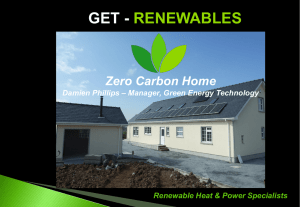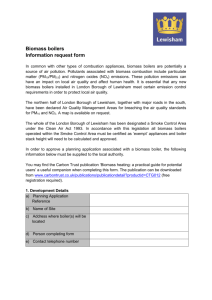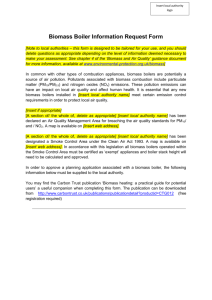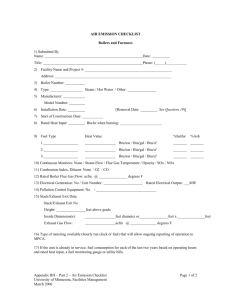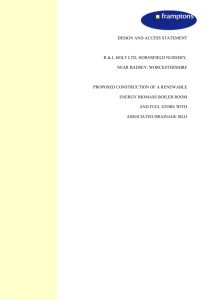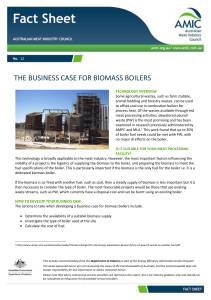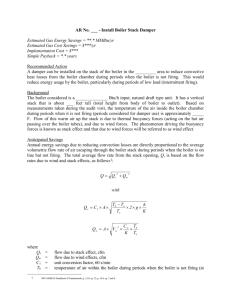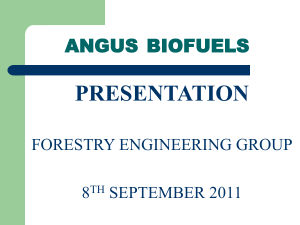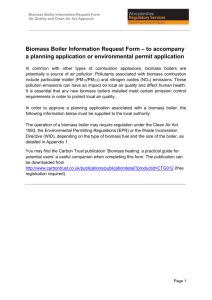Biomass Boiler Information Request Form
advertisement
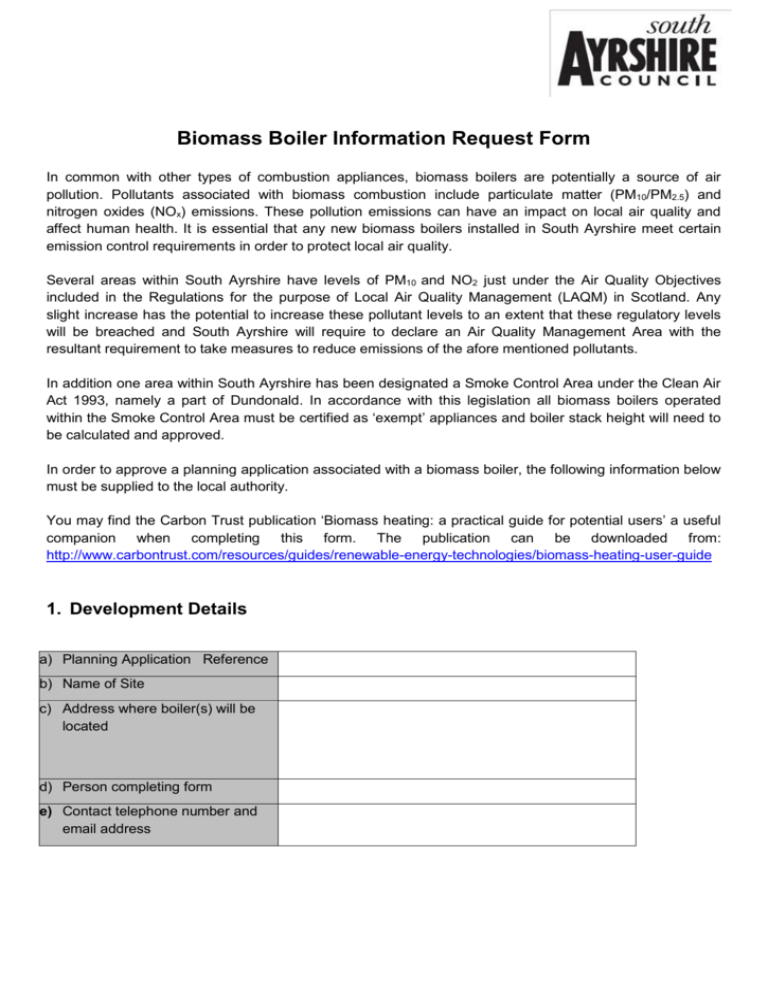
Biomass Boiler Information Request Form In common with other types of combustion appliances, biomass boilers are potentially a source of air pollution. Pollutants associated with biomass combustion include particulate matter (PM10/PM2.5) and nitrogen oxides (NOx) emissions. These pollution emissions can have an impact on local air quality and affect human health. It is essential that any new biomass boilers installed in South Ayrshire meet certain emission control requirements in order to protect local air quality. Several areas within South Ayrshire have levels of PM10 and NO2 just under the Air Quality Objectives included in the Regulations for the purpose of Local Air Quality Management (LAQM) in Scotland. Any slight increase has the potential to increase these pollutant levels to an extent that these regulatory levels will be breached and South Ayrshire will require to declare an Air Quality Management Area with the resultant requirement to take measures to reduce emissions of the afore mentioned pollutants. In addition one area within South Ayrshire has been designated a Smoke Control Area under the Clean Air Act 1993, namely a part of Dundonald. In accordance with this legislation all biomass boilers operated within the Smoke Control Area must be certified as ‘exempt’ appliances and boiler stack height will need to be calculated and approved. In order to approve a planning application associated with a biomass boiler, the following information below must be supplied to the local authority. You may find the Carbon Trust publication ‘Biomass heating: a practical guide for potential users’ a useful companion when completing this form. The publication can be downloaded from: http://www.carbontrust.com/resources/guides/renewable-energy-technologies/biomass-heating-user-guide 1. Development Details a) Planning Application Reference b) Name of Site c) Address where boiler(s) will be located d) Person completing form e) Contact telephone number and email address 2. Particulars of the Boiler This information on the basic design of the system will help us assess the emissions performance. Biomass boilers often produce relatively high emissions when lightly loaded, hence the question regarding an accumulation tank (heat store). The boiler manufacturer and/ or installer should be able to help you provide this information. f) Describe the proposed biomass boiler including make, model, manufacturer, thermal capacity (kw/MW), efficiency, maximum rate of fuel consumption (kg/hr or m3/hr). g) Provide details of the abatement equipment in place for controlling particulate matter (fly ash) emissions. h) Is the biomass boiler an exempt appliance in accordance with the Clean Air Act 1993? If yes provide evidence to demonstrate the biomass boiler has been tested and certified as an exempt appliance (for example a link to the appliance on the UK Smoke Control Areas website http://www.uksmokecontrolareas.co.uk/appliances.php) 4. Boiler Stack Details The design of the stack greatly affects how pollutants produced in the boiler disperse over the surrounding area. Where the area is heavily built up, or has existing air quality issues, dispersion becomes more complicated and a computer modelling technique known as dispersion modelling may be required. Your installer should be able to provide most of the details and make a calculation on stack height and design. When dispersion modelling is required you or your installer may need to engage a specialist consultant. i) Identify the height of the boiler exhaust stack above ground. The height should be calculated using dispersion modelling software such as ADMS 4 or Aermod [delete if dispersion modelling is not required] Evidence shall be presented to demonstrate that predicted emission concentrations associated with the calculated stack height do not have a significant impact on the air quality objectives for NO2 and PM10. j) Identify stack internal diameter (m). k) Provide maximum particulate matter and nitrogen oxides emission rates (mg/m3 or g/hr) to standard reference conditions (6% oxygen, 273K, 101.3kPa). l) Identify the exhaust gas efflux velocity (m/s). m) Provide the grid reference of boiler exhaust stack. 6. Building Details The height and distance of neighbouring buildings will determine their exposure to emissions from the biomass boiler, and therefore the height of the stack needed. Your architect should be able to provide this information. n) Record the distance of adjacent buildings (within a distance of 5 times the height of the proposed stack) from boiler exhaust stack. o) Record the height and width of adjacent buildings (within a distance of 5 times the height of the proposed stack) from boiler exhaust stack. p) Record the dimensions of building to which the boiler exhaust stack is attached. q) Indicate the distance from the boiler exhaust stack to the nearest fan assisted intakes and openable windows. 7. Plans Please attach the following to this form: A site plan showing the location of the boiler room, fuel storage area and the access and exit route for fuel delivery vehicles, and A site plan showing the position of the boiler exhaust stack, fan assisted intake air vents and nearest openable windows. 8. Returning this form Please return this form to: Environmental Health Section 3rd Floor Burns House Burns Statue Square Ayr KA71LU FAO Gordon Lauder. Tel: 01292 618222 Email: environmental.health@south-ayrshire.gov.uk



